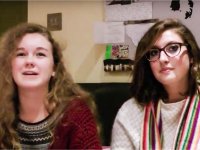Wait, You’re From Where? Integrating Third Culture Kids in Your Classroom
Third Culture Kids have spent years outside of their parents’ culture. Learn the do’s and don’t of welcoming these sometimes “hidden immigrants” into your classroom.
Students enter classrooms across the country with unique stories. Their stories impact who they are, how they learn, and how they engage with others. Sometimes, though, their stories don't seem to make sense -- for example, a boy who appears European by descent but tells you that he's from Asia. At the beginning of the day, he bows to you as a sign of respect while his classmates laugh. You later find out that he was born in California, then lived in China for ten years and only recently moved back to the United States.
These students are Third Culture Kids (TCKs), defined on tckid.com as "a person who has spent a significant part of his or her developmental years outside of their parents' culture." After living in their "host country," they often return to their "home country," or country of citizenship.
This transition can be challenging for a TCK, according to author and speaker Tina Quick. Because these students appear identical to their non-TCK counterparts, others expect them to know the norms of the school environment. Revealing that they are "foreigners" can be embarrassing and intimidating, as David C. Pollock mentions in his paper "Being a Third-Culture Kid: A Profile" (PDF).
When you realize that you have a TCK in your classroom, following these guidelines and incorporating these strategies into your teaching can help to integrate this new student into your learning community:
Do's
Give them opportunities to explore their identity.
TCKs live in a world of constant transition as they travel between cultures. Because these transitions take place while they are also developing their sense of identity (PDF), TCKs may not yet fully understand themselves.
Strategies: Assigning reflective assignments and journal entries provides the TCK with a safe space to discover her identity. Personal and family histories can also help TCKs reconnect with their own heritage.
Get to know them.
Each TCK has a unique story that informs his perspective. Knowing that story leads to a fuller understanding of the student, and may also explain why he is unaware of routines that you think are common sense.
Strategies: When you meet a TCK, ask questions and show interest in past experiences. This interest helps the TCK feel understood and safe in a new environment.
Connect them with other students.
Some TCKs tend to be outgoing, while others remain shy and reserved. Many fear making a cultural faux pas -- the embarrassment of which is magnified by the fact that, as a hidden immigrant, they look like their classmates and are expected to know norms. Helping a TCK make friends increases her comfort within the classroom.
Strategies: Using collaborative activities during a lesson or assigning roles during group work gives a TCK a sense of belonging in a new environment. By having a role in the community, the TCK begins to build relationships with classmates.
Don’ts
Make assumptions.
Remember, this new school environment may be completely foreign for a TCK. Prior to attending school in his home country, a TCK may have attended a local foreign school, a private international school, a religious school, or have been homeschooled. Don't assume knowledge of routines and procedures for the school day.
Strategies: Pick an outgoing student and assign him as a buddy to show the newcomer the most important places in school, such as the bathroom and the cafeteria. By having a single classmate as a resource, the TCK will be able to ask questions without feeling threatened.
Make generalizations.
Living in Africa does not mean that a TCK lived in a grass hut. Making generalizations about a TCK's life based on where she lived can be insulting and disorienting for this child. Avoid phrases like, "You must have done _______ while you were over there."
Strategies: When talking to the TCK, ask open-ended questions. This allows the TCK to share her experiences without feeling uncomfortable or falling short of an expectation. In addition, conduct research about the country in which the TCK lived.
Ignore their diversity.
The TCK upbringing equips this student with a unique life experience that evolves into worldviews and perspectives, also described by David C. Pollock (PDF). When appropriate in the classroom, listen to the TCK and ask him to share if he is comfortable. Doing so can lead to stimulating discussions for you and your students about the world outside the walls of your classroom.
Strategies: Teaching global lessons in your class can open an avenue for the TCK to contribute. Allow for group discussions, which in turn can develop cross-cultural skills among the rest of the class.
A Welcoming Environment
With the rate of globalization, ease of air travel, and increasing likelihood that companies will send associates overseas, odds are that any teacher will eventually find a TCK sitting in his or her classroom -- if that hasn't already happened. Being prepared with these strategies can help the TCK to smoothly integrate to the new and "foreign" classroom community.
How do you welcome TCKs to your classroom? Please share your experiences below in the comments section.
